2001 FORD F350 engine coolant
[x] Cancel search: engine coolantPage 209 of 288
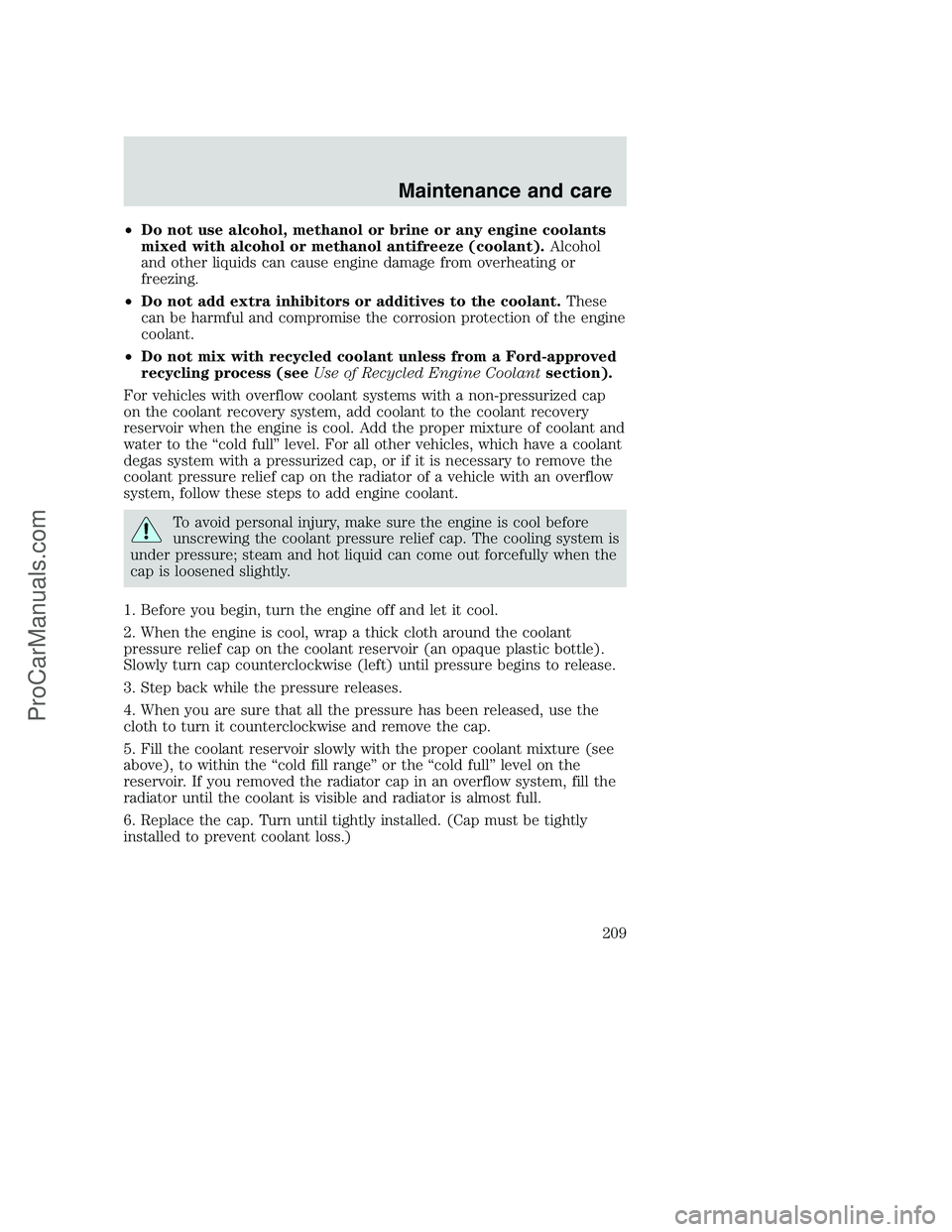
•Do not use alcohol, methanol or brine or any engine coolants
mixed with alcohol or methanol antifreeze (coolant).Alcohol
and other liquids can cause engine damage from overheating or
freezing.
•Do not add extra inhibitors or additives to the coolant.These
can be harmful and compromise the corrosion protection of the engine
coolant.
•Do not mix with recycled coolant unless from a Ford-approved
recycling process (seeUse of Recycled Engine Coolantsection).
For vehicles with overflow coolant systems with a non-pressurized cap
on the coolant recovery system, add coolant to the coolant recovery
reservoir when the engine is cool. Add the proper mixture of coolant and
water to the “cold full” level. For all other vehicles, which have a coolant
degas system with a pressurized cap, or if it is necessary to remove the
coolant pressure relief cap on the radiator of a vehicle with an overflow
system, follow these steps to add engine coolant.
To avoid personal injury, make sure the engine is cool before
unscrewing the coolant pressure relief cap. The cooling system is
under pressure; steam and hot liquid can come out forcefully when the
cap is loosened slightly.
1. Before you begin, turn the engine off and let it cool.
2. When the engine is cool, wrap a thick cloth around the coolant
pressure relief cap on the coolant reservoir (an opaque plastic bottle).
Slowly turn cap counterclockwise (left) until pressure begins to release.
3. Step back while the pressure releases.
4. When you are sure that all the pressure has been released, use the
cloth to turn it counterclockwise and remove the cap.
5. Fill the coolant reservoir slowly with the proper coolant mixture (see
above), to within the “cold fill range” or the “cold full” level on the
reservoir. If you removed the radiator cap in an overflow system, fill the
radiator until the coolant is visible and radiator is almost full.
6. Replace the cap. Turn until tightly installed. (Cap must be tightly
installed to prevent coolant loss.)
Maintenance and care
209
ProCarManuals.com
Page 210 of 288
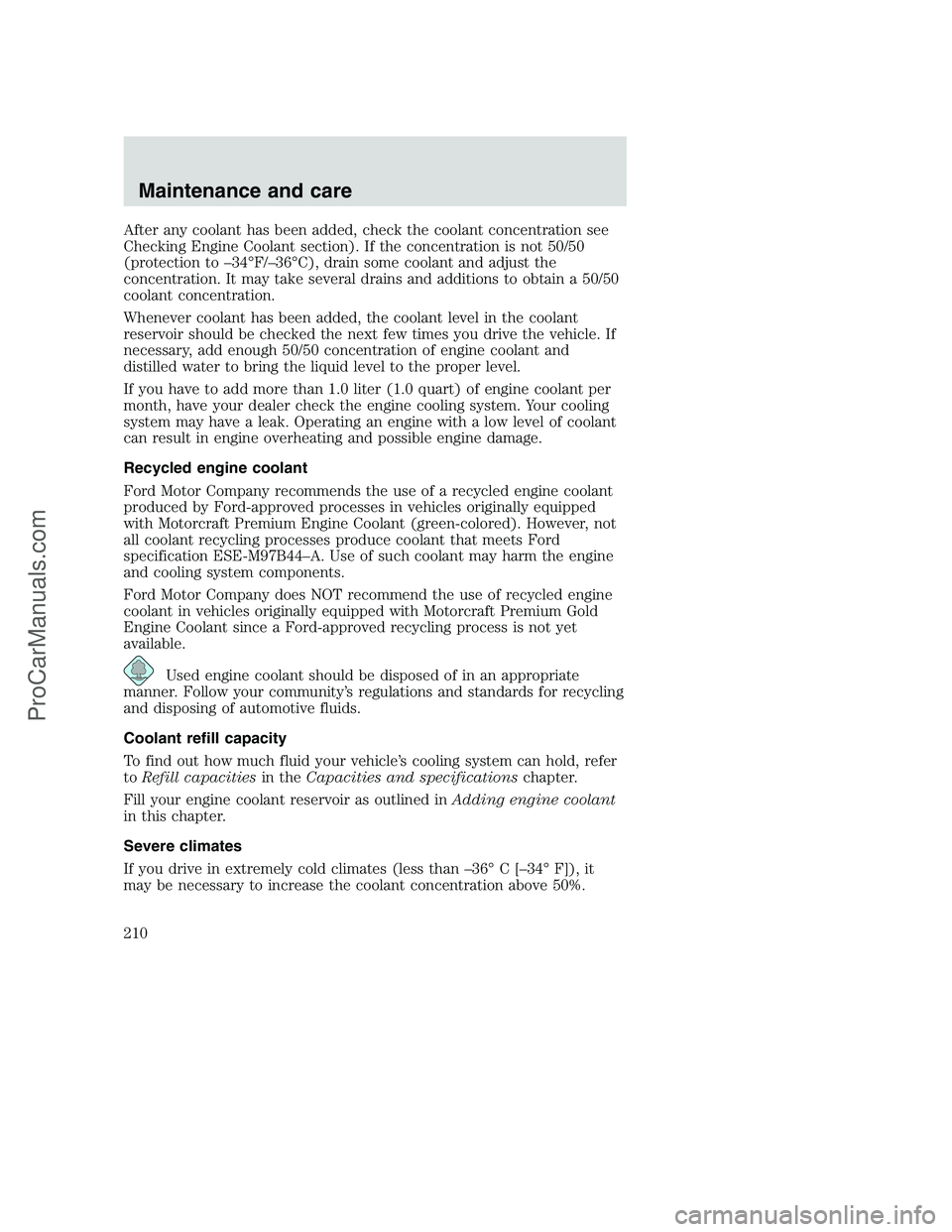
After any coolant has been added, check the coolant concentration see
Checking Engine Coolant section). If the concentration is not 50/50
(protection to –34°F/–36°C), drain some coolant and adjust the
concentration. It may take several drains and additions to obtain a 50/50
coolant concentration.
Whenever coolant has been added, the coolant level in the coolant
reservoir should be checked the next few times you drive the vehicle. If
necessary, add enough 50/50 concentration of engine coolant and
distilled water to bring the liquid level to the proper level.
If you have to add more than 1.0 liter (1.0 quart) of engine coolant per
month, have your dealer check the engine cooling system. Your cooling
system may have a leak. Operating an engine with a low level of coolant
can result in engine overheating and possible engine damage.
Recycled engine coolant
Ford Motor Company recommends the use of a recycled engine coolant
produced by Ford-approved processes in vehicles originally equipped
with Motorcraft Premium Engine Coolant (green-colored). However, not
all coolant recycling processes produce coolant that meets Ford
specification ESE-M97B44–A. Use of such coolant may harm the engine
and cooling system components.
Ford Motor Company does NOT recommend the use of recycled engine
coolant in vehicles originally equipped with Motorcraft Premium Gold
Engine Coolant since a Ford-approved recycling process is not yet
available.
Used engine coolant should be disposed of in an appropriate
manner. Follow your community’s regulations and standards for recycling
and disposing of automotive fluids.
Coolant refill capacity
To find out how much fluid your vehicle’s cooling system can hold, refer
toRefill capacitiesin theCapacities and specificationschapter.
Fill your engine coolant reservoir as outlined inAdding engine coolant
in this chapter.
Severe climates
If you drive in extremely cold climates (less than –36° C [–34° F]), it
may be necessary to increase the coolant concentration above 50%.
Maintenance and care
210
ProCarManuals.com
Page 211 of 288

Refer to the chart on the coolant container to ensure the coolant
concentration in your vehicle will provide adequate freeze protection.
Never increase the engine coolant concentration above 60%
(protection to –60°F). At a level over 60%, your engine could overheat
and become damaged.
If you drive in extremely hot climates, it is still necessary to maintain the
coolant concentration at 50/50 coolant and water.Do not allow the
coolant concentration to fall below 40% coolant.At a concentration
less than 40%, the corrosion protection to your engine and cooling
components may be compromised and permanent damage may result.
What you should know about fail-safe cooling (if equipped)
If the engine coolant supply is depleted, this feature allows the vehicle to
be driven temporarily before incremental component damage is incurred.
The “fail-safe” distance depends on ambient temperatures, vehicle load
and terrain.
How fail-safe cooling works
If the engine begins to overheat:
•The engine coolant temperature
gauge will move to the red (hot)
area.
•The
andsymbol will
illuminate.
•TheService Engine Soon
indicator light will illuminate.
If the engine reaches a preset over-temperature condition, the engine
will automatically switch to alternating cylinder operation. Each disabled
cylinder acts as an air pump and cools the engine.
When this occurs the vehicle will still operate. However:
•The engine power will be limited.
•The air conditioning system will be disabled.
Continued operation will increase the engine temperature and the engine
will completely shut down, causing steering and braking effort to
increase.
Once the engine temperature cools, the engine can be re-started. Take
your vehicle to a service facility as soon as possible to minimize engine
damage.
H
C
Maintenance and care
211
ProCarManuals.com
Page 212 of 288
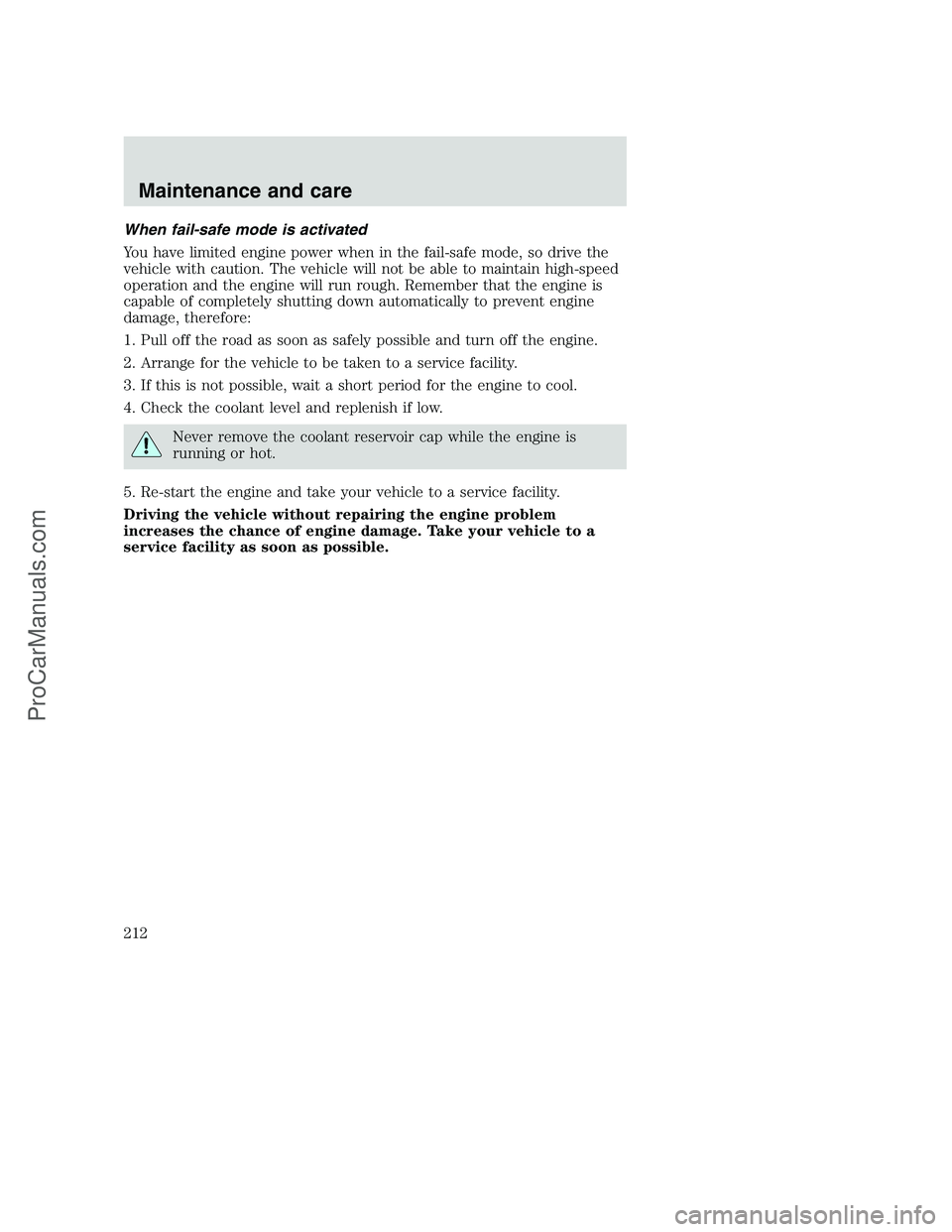
When fail-safe mode is activated
You have limited engine power when in the fail-safe mode, so drive the
vehicle with caution. The vehicle will not be able to maintain high-speed
operation and the engine will run rough. Remember that the engine is
capable of completely shutting down automatically to prevent engine
damage, therefore:
1. Pull off the road as soon as safely possible and turn off the engine.
2. Arrange for the vehicle to be taken to a service facility.
3. If this is not possible, wait a short period for the engine to cool.
4. Check the coolant level and replenish if low.
Never remove the coolant reservoir cap while the engine is
running or hot.
5. Re-start the engine and take your vehicle to a service facility.
Driving the vehicle without repairing the engine problem
increases the chance of engine damage. Take your vehicle to a
service facility as soon as possible.
Maintenance and care
212
ProCarManuals.com
Page 250 of 288
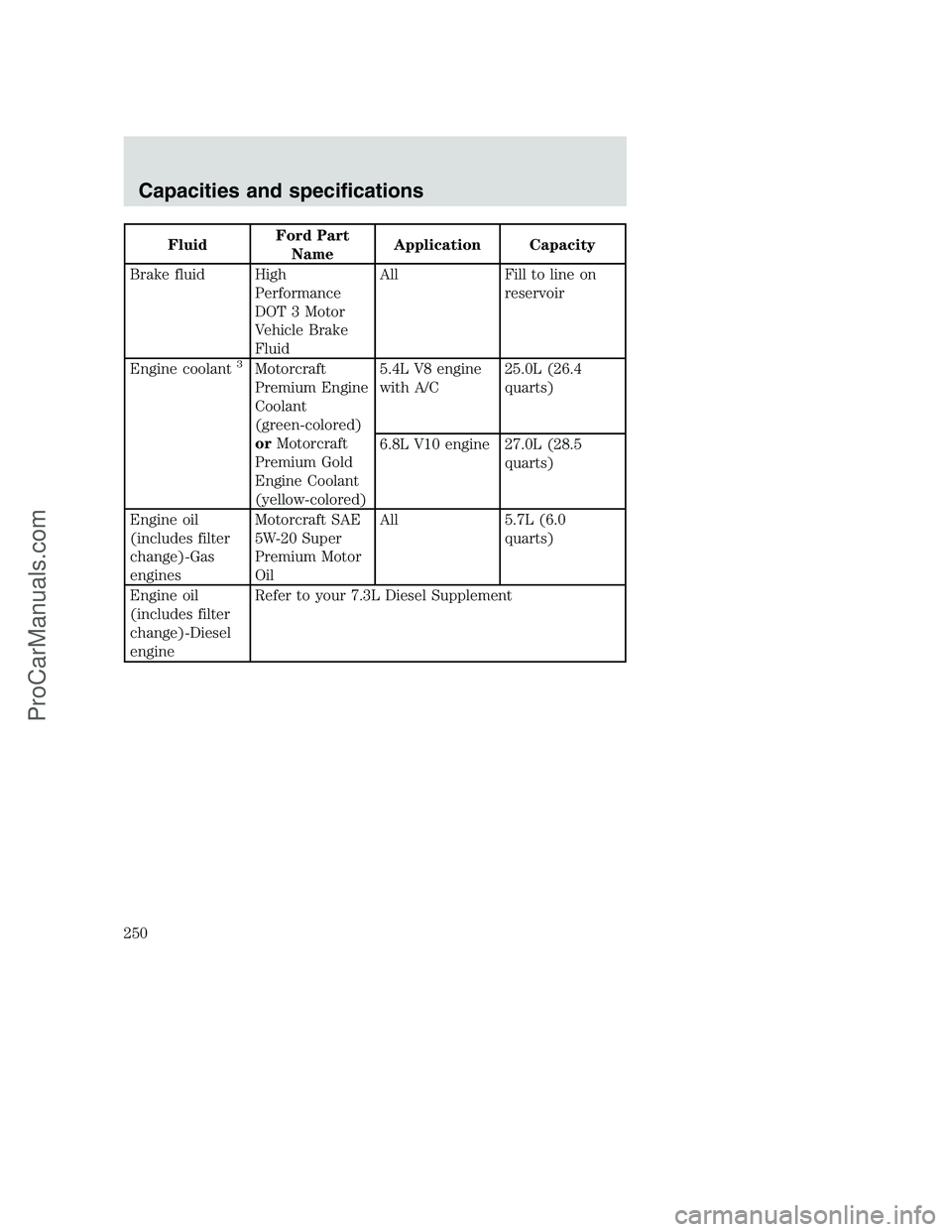
FluidFord Part
NameApplication Capacity
Brake fluid High
Performance
DOT 3 Motor
Vehicle Brake
FluidAll Fill to line on
reservoir
Engine coolant
3Motorcraft
Premium Engine
Coolant
(green-colored)
orMotorcraft
Premium Gold
Engine Coolant
(yellow-colored)5.4L V8 engine
with A/C25.0L (26.4
quarts)
6.8L V10 engine 27.0L (28.5
quarts)
Engine oil
(includes filter
change)-Gas
enginesMotorcraft SAE
5W-20 Super
Premium Motor
OilAll 5.7L (6.0
quarts)
Engine oil
(includes filter
change)-Diesel
engineRefer to your 7.3L Diesel Supplement
Capacities and specifications
250
ProCarManuals.com
Page 253 of 288
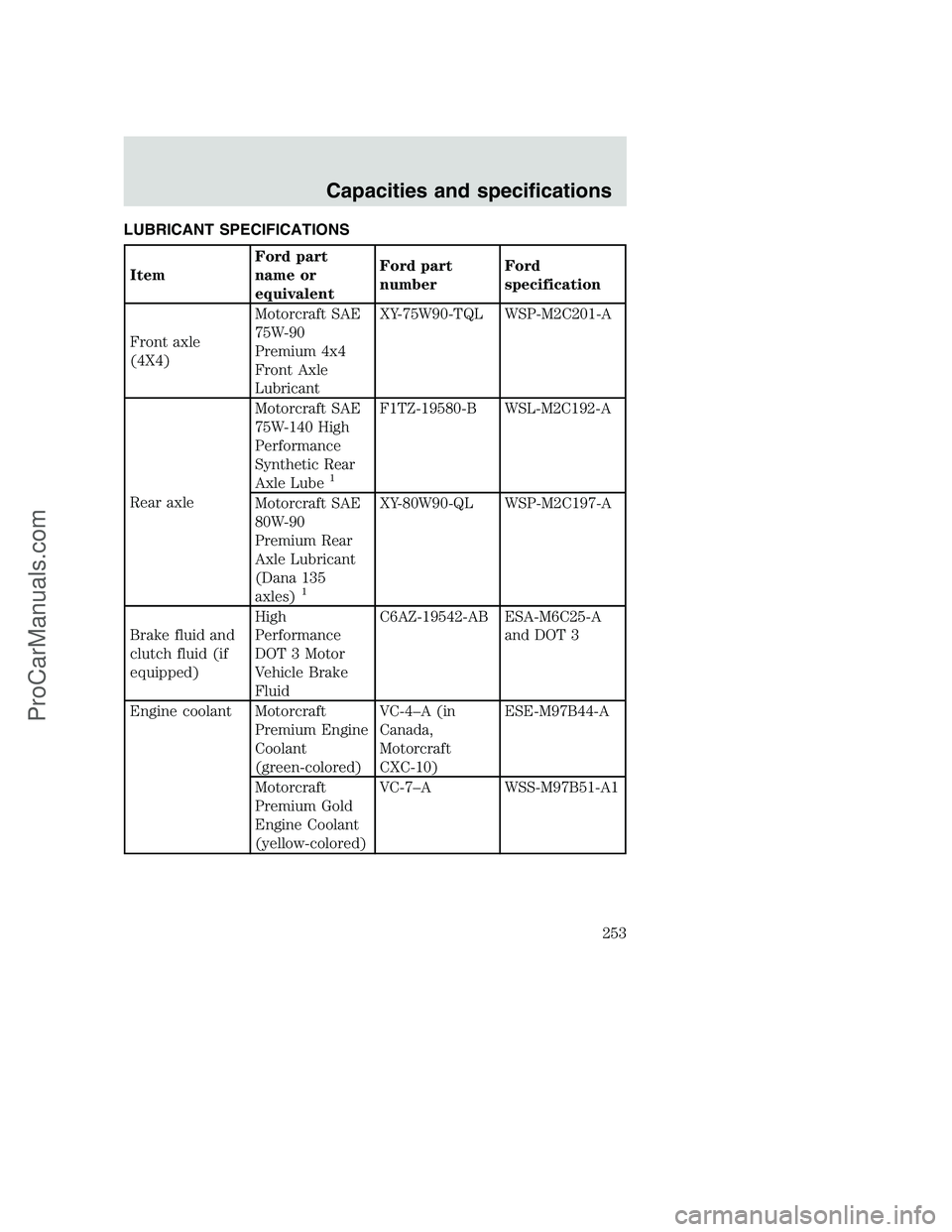
LUBRICANT SPECIFICATIONS
ItemFord part
name or
equivalentFord part
numberFord
specification
Front axle
(4X4)Motorcraft SAE
75W-90
Premium 4x4
Front Axle
LubricantXY-75W90-TQL WSP-M2C201-A
Rear axleMotorcraft SAE
75W-140 High
Performance
Synthetic Rear
Axle Lube
1
F1TZ-19580-B WSL-M2C192-A
Motorcraft SAE
80W-90
Premium Rear
Axle Lubricant
(Dana 135
axles)
1
XY-80W90-QL WSP-M2C197-A
Brake fluid and
clutch fluid (if
equipped)High
Performance
DOT 3 Motor
Vehicle Brake
FluidC6AZ-19542-AB ESA-M6C25-A
and DOT 3
Engine coolant Motorcraft
Premium Engine
Coolant
(green-colored)VC-4–A (in
Canada,
Motorcraft
CXC-10)ESE-M97B44-A
Motorcraft
Premium Gold
Engine Coolant
(yellow-colored)VC-7–A WSS-M97B51-A1
Capacities and specifications
253
ProCarManuals.com
Page 278 of 288

A
Accessory delay ..........................80
Air bag supplemental
restraint system ........................107
and child safety seats ............109
description ..............................107
disposal ....................................111
driver air bag ..........................109
indicator light ...................11, 111
operation .................................109
passenger air bag ...................109
passenger deactivation
switch ......................................112
Air cleaner filter .......217–218, 249
Air conditioning ..........................29
Ambulance packages ....................4
Antifreeze (see Engine
coolant) .....................................206
Anti-lock brake system
(see Brakes) ......................131–132
Audio system (see Radio) ...35, 56
Automatic transmission
driving an automatic
overdrive .................................137
fluid, adding ............................214
fluid, checking ........................214
fluid, refill capacities ..............249
fluid, specification ..................256
Auxiliary power point ...........29, 83
Axle
lubricant specifications ..253, 256
refill capacities ........................249
traction lok ..............................134
B
Battery .......................................219acid, treating emergencies .....219
charging system
warning light .............................13
jumping a disabled battery ....191
maintenance-free ....................219
replacement, specifications ...249
servicing ..................................219
voltage gauge ............................19
Belt minder ...............................103
Brakes ........................................131
anti-lock ...........................131–132
anti-lock brake system
(ABS) warning light .........13, 132
brake warning light ..................12
fluid, checking and adding ....204
fluid, refill capacities ..............249
fluid, specifications .........253, 256
lubricant specifications ..253, 256
parking ....................................133
pedals (see Power adjustable
foot pedals) ...............................26
shift interlock ..........................136
Break-in period .............................3
C
Capacities for refilling fluids ....249
Certification Label ....................261
Child safety restraints ..............117
child safety belts ....................117
Child safety seats ......................118
attaching with tether straps ..122
in front seat ............................119
in rear seat ..............................119
tether anchorage hardware ...122
Cleaning your vehicle ...............243
engine compartment ..............246
exterior ............................244–245
exterior lamps .........................246
Index
278
ProCarManuals.com
Page 279 of 288
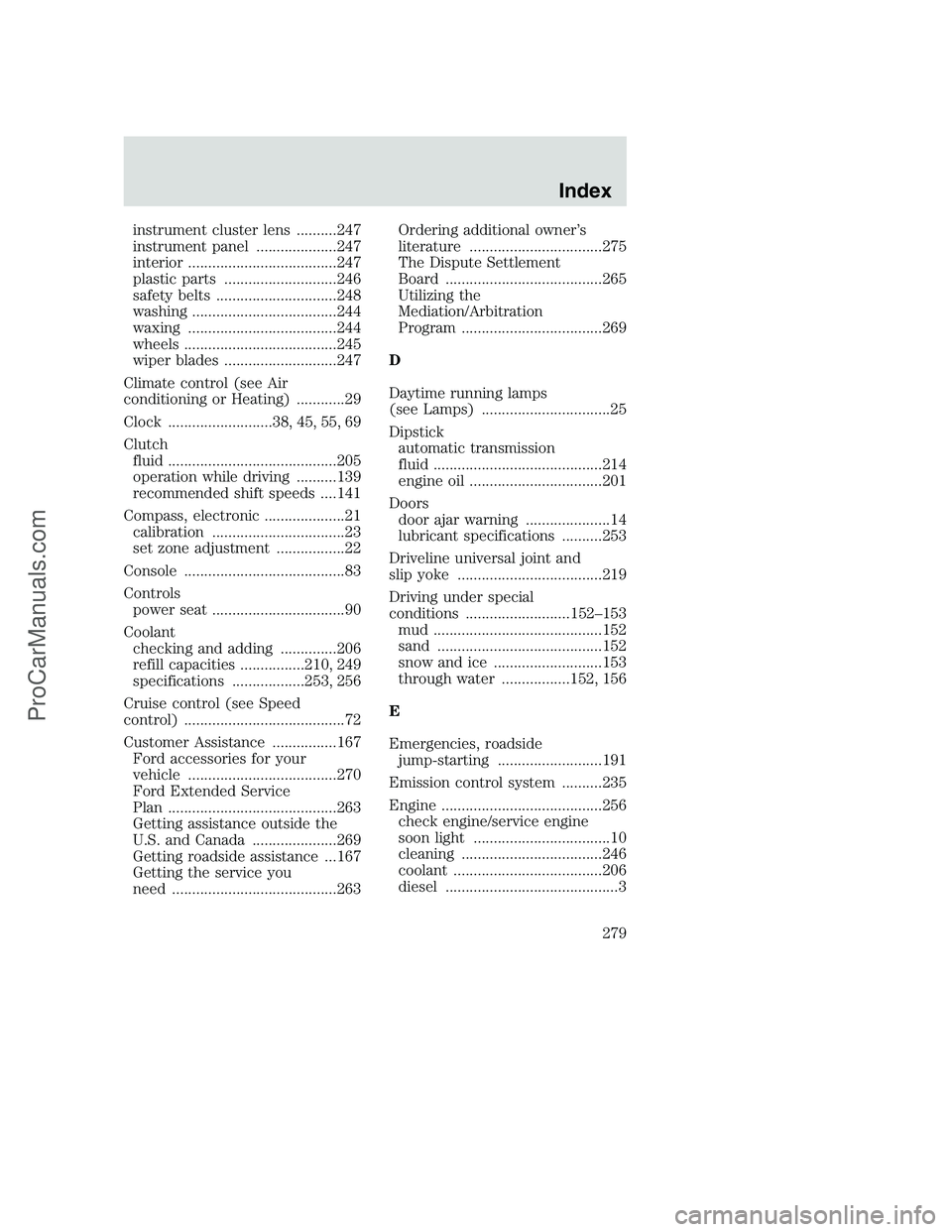
instrument cluster lens ..........247
instrument panel ....................247
interior .....................................247
plastic parts ............................246
safety belts ..............................248
washing ....................................244
waxing .....................................244
wheels ......................................245
wiper blades ............................247
Climate control (see Air
conditioning or Heating) ............29
Clock ..........................38, 45, 55, 69
Clutch
fluid ..........................................205
operation while driving ..........139
recommended shift speeds ....141
Compass, electronic ....................21
calibration .................................23
set zone adjustment .................22
Console ........................................83
Controls
power seat .................................90
Coolant
checking and adding ..............206
refill capacities ................210, 249
specifications ..................253, 256
Cruise control (see Speed
control) ........................................72
Customer Assistance ................167
Ford accessories for your
vehicle .....................................270
Ford Extended Service
Plan ..........................................263
Getting assistance outside the
U.S. and Canada .....................269
Getting roadside assistance ...167
Getting the service you
need .........................................263Ordering additional owner’s
literature .................................275
The Dispute Settlement
Board .......................................265
Utilizing the
Mediation/Arbitration
Program ...................................269
D
Daytime running lamps
(see Lamps) ................................25
Dipstick
automatic transmission
fluid ..........................................214
engine oil .................................201
Doors
door ajar warning .....................14
lubricant specifications ..........253
Driveline universal joint and
slip yoke ....................................219
Driving under special
conditions ..........................152–153
mud ..........................................152
sand .........................................152
snow and ice ...........................153
through water .................152, 156
E
Emergencies, roadside
jump-starting ..........................191
Emission control system ..........235
Engine ........................................256
check engine/service engine
soon light ..................................10
cleaning ...................................246
coolant .....................................206
diesel ...........................................3
Index
279
ProCarManuals.com